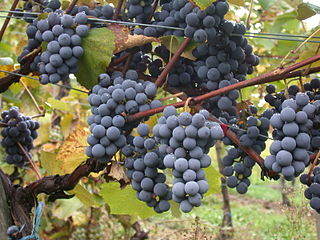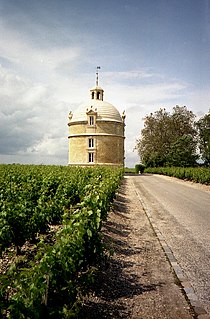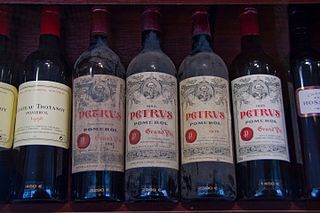A fumarium was a smoke chamber used in ancient Rome to enhance the flavor of wine through artificially "aging" the wine. Amphorae were placed in the chamber, which was built on top of a heated hearth, in order to impart a smoky flavor in the wine that also seemed to sharpen the acidity. The wine would sometimes come out of the fumarium with a paler color. In his book Vintage: The Story of Wine, Hugh Johnson noted that Pliny the Elder and Columella did not recommend that "first-growth wines" like Falernian, Caecuban, and Alban be smoked. [1]
For preservation, the amphorae were sometimes treated with sulphur dioxide prior to being placed in the fumarium. In his book, The Cyclopedia of Biblical Literature, John Kitto states that the ban on smoked wines as offerings in the Mishna stemmed from the Roman use of sulphur fumes - a uniquely Gentile technique. [2]

Wine is an alcoholic drink typically made from fermented grapes. Yeast consumes the sugar in the grapes and converts it to ethanol and carbon dioxide, releasing heat in the process. Different varieties of grapes and strains of yeasts are major factors in different styles of wine. These differences result from the complex interactions between the biochemical development of the grape, the reactions involved in fermentation, the grape's growing environment (terroir), and the wine production process. Many countries enact legal appellations intended to define styles and qualities of wine. These typically restrict the geographical origin and permitted varieties of grapes, as well as other aspects of wine production. Wines not made from grapes involve fermentation of other crops including rice wine and other fruit wines such as plum, cherry, pomegranate, currant and elderberry.

Retsina is a Greek white resinated wine, which has been made for at least 2,000 years. Its unique flavor is said to have originated from the practice of sealing wine vessels, particularly amphorae, with Aleppo Pine resin in ancient times. Before the invention of impermeable glass bottles, oxygen caused many wines to spoil within the year. Pine resin helped keep air out, while infusing the wine with resin aroma. The Romans began to use barrels in the 3rd century AD, removing any oenological necessity for resin, but the flavor itself was so popular that the style is still widespread today.

Gamay is a purple-colored grape variety used to make red wines, most notably grown in Beaujolais and in the Loire Valley around Tours. Its full name is Gamay Noir à Jus Blanc. It is a very old cultivar, mentioned as long ago as the 15th century. It has been often cultivated because it makes for abundant production; however, it can produce wines of distinction when planted on acidic soils, which help to soften the grape's naturally high acidity.

Oak is used in winemaking to vary the color, flavor, tannin profile and texture of wine. It can be introduced in the form of a barrel during the fermentation or aging periods, or as free-floating chips or staves added to wine fermented in a vessel like stainless steel. Oak barrels can impart other qualities to wine through evaporation and low level exposure to oxygen.

The subjective sweetness of a wine is determined by the interaction of several factors, including the amount of sugar in the wine, but also the relative levels of alcohol, acids, and tannins. Sugars and alcohol enhance a wine's sweetness; acids (sourness) and bitter tannins counteract it. These principles are outlined in the 1987 work by Émile Peynaud, The Taste of Wine.
John Kitto was an English biblical scholar of Cornish descent.

Sauternes is a French sweet wine from the region of the same name in the Graves section in Bordeaux. Sauternes wine is made from sémillon, sauvignon blanc, and muscadelle grapes that have been affected by Botrytis cinerea, also known as noble rot. This causes the grapes to become partially raisined, resulting in concentrated and distinctively flavored wines. Due to its climate, Sauternes is one of the few wine regions where infection with noble rot is a frequent occurrence. Even so, production is a hit-or-miss proposition, with widely varying harvests from vintage to vintage. Wines from Sauternes, especially the Premier Cru Supérieur estate Château d'Yquem, can be very expensive, largely due to the very high cost of production. Barsac lies within Sauternes and is entitled to use either name. Somewhat similar but less expensive and typically less-distinguished wines are produced in the neighboring regions of Monbazillac, Cérons, Loupiac and Cadillac. In the United States, there is a semi-generic label for sweet white dessert wines known as sauterne without the "s" at the end and uncapitalized.

Hugh Eric Allan Johnson is an English journalist, author, editor, and expert on wine. He is considered the world's best-selling wine writer. A wine he tasted in 1964, a 1540 Steinwein from the German vineyard Würzburger Stein, is considered one of the oldest to have ever been tasted.
Falernian was a strong white wine popular in the classical Roman period, produced from Aglianico grapes on the slopes of Mount Falernus near the border of Latium and Campania. From here, Falernian wine grew in popularity, becoming the one of the most highly regarded wines accessible to and consumed by the ancient Romans. In an Epyllion written in c.92 AD, Silius Italicus, a prominent Roman senator, attributed its origin to a chance meeting between a mythic pauper named Falernus, who was said to have lived on Mount Falernus in the late 3rd century BC, and Liber, the Roman god of viticulture. Considered a "first growth" or "cult wine" for its time, it was often mentioned in Roman literature, but disappeared after the classical period. There were three vineyards recognized by Romans: Caucinian Falernian from the vineyards on the highest slopes of Mount Falernus; Faustian Falernian, the most famous, from land on the central slopes corresponding to the current hilly areas of the town of Falciano del Massico and Carinola di Casanova, owned by Faustus, son of the Roman dictator Sulla; and wine from the lower slopes and plain that was simply called Falernian. The area is now occupied by the modern day vineyards of Rocca di Mondragone and Monte Massico.

A wine cellar is a storage room for wine in bottles or barrels, or more rarely in carboys, amphorae, or plastic containers. In an active wine cellar, important factors such as temperature and humidity are maintained by a climate control system. In contrast, passive wine cellars are not climate-controlled, and are usually built underground to reduce temperature swings. An aboveground wine cellar is often called a wine room, while a small wine cellar is sometimes termed a wine closet. The household department responsible for the storage, care and service of wine in a great mediaeval house was termed the buttery. Large wine cellars date back over 3700 years.

Wine has been produced for thousands of years, with evidence of ancient wine production in Georgia from c. 6000 BC , West Azerbaijan province of Iran from c. 5000 BC, Armenia from c. 4100 BC, and Sicily from c. 4000 BC. The earliest evidence of a grape and rice mixed based fermented drink sometimes compared to wine was found in ancient China.

The history of Bordeaux wine spans almost 2000 years to Roman times when the first vineyards were planted. In the Middle Ages, the marriage of Henry Plantagenet and Eleanor of Aquitaine opened the Bordeaux region to the English market and eventually to the world's stage. The Gironde estuary and its tributaries, the Garonne and the Dordogne rivers play a pivotal role in the history and success of this region.

Ancient Rome played a pivotal role in the history of wine. The earliest influences on the viticulture of the Italian peninsula can be traced to ancient Greeks and the Etruscans. The rise of the Roman Empire saw both technological advances in and burgeoning awareness of winemaking, which spread to all parts of the empire. Rome's influence has had a profound effect on the histories of today's major winemaking regions in France, Germany, Italy, Portugal and Spain.

The aging of wine is potentially able to improve the quality of wine. This distinguishes wine from most other consumable goods. While wine is perishable and capable of deteriorating, complex chemical reactions involving a wine's sugars, acids and phenolic compounds can alter the aroma, color, mouthfeel and taste of the wine in a way that may be more pleasing to the taster. The ability of a wine to age is influenced by many factors including grape variety, vintage, viticultural practices, wine region and winemaking style. The condition that the wine is kept in after bottling can also influence how well a wine ages and may require significant time and financial investment. The quality of an aged wine varies significantly bottle-by-bottle, depending on the conditions under which it was stored, and the condition of the bottle and cork, and thus it is said that rather than good old vintages, there are good old bottles. There is a significant mystique around the aging of wine, as its chemistry was not understood for a long time, and old wines are often sold for extraordinary prices. However, the vast majority of wine is not aged, and even wine that is aged is rarely aged for long; it is estimated that 90% of wine is meant to be consumed within a year of production, and 99% of wine within 5 years.

Comet vintages are years during which an astronomical event, involving generally a "Great Comet", occurs prior to harvest. Throughout the history of wine, winemakers have attributed successful vintages and ideal weather conditions to the unexplained effects caused by the comets. Some of the most heralded vintages in the last couple of centuries—such as the 1811, 1826, 1839, 1845, 1852, 1858, 1861, 1985, and 1989 vintages—have coincided with a notable appearance of a comet. There is no scientific basis for any effect of comets on viticulture, but the term nevertheless remains in use.

Pomerol is a French wine-growing commune and Appellation d'origine contrôlée (AOC) within the Libournais in Bordeaux. The wine produced here is predominately from Merlot with Cabernet Franc playing a supporting role. Unlike most other Bordeaux communes, there is no real village of Pomerol, although there is a church. The houses are set among the vineyards.
Ancient Israelite cuisine refers to the culinary practices of the Israelites during a period of over a millennium. It took root in its known form with the beginning of the Israelite presence in the Land of Israel during the Late Bronze Age and is generally considered to have been maintained up until the mass expulsion of Jews from Roman Judea in the 2nd century CE. Dietary staples among the Israelites were bread, wine, and olive oil; also included were legumes, fruits and vegetables, dairy products, fish, and meat.
Dominick McCausland or Dominick M'Causland LL.D. QC (1806–1873) was an Irish barrister and Christian author.

The history of the wine press and of pressing is nearly as old as the history of wine itself with the remains of wine presses providing some of the longest-serving evidence of organised viticulture and winemaking in the ancient world. The earliest wine press was probably the human foot or hand, crushing and squeezing grapes into a bag or container where the contents would ferment.